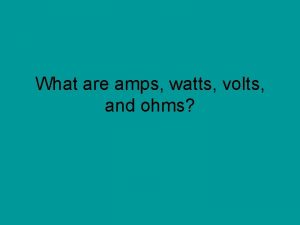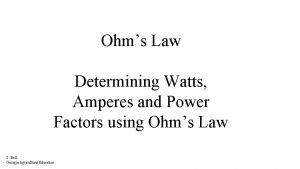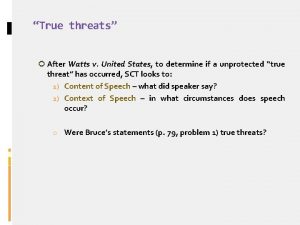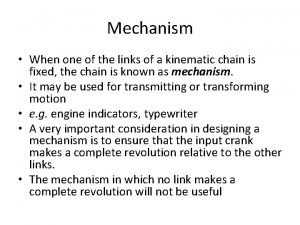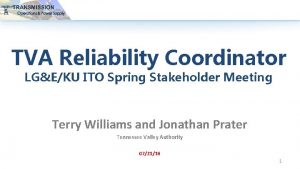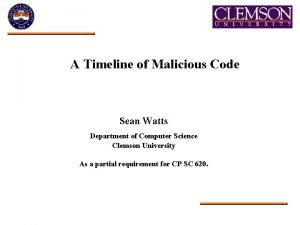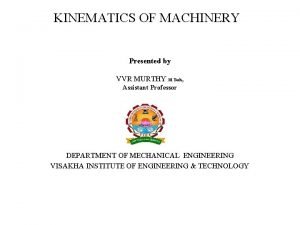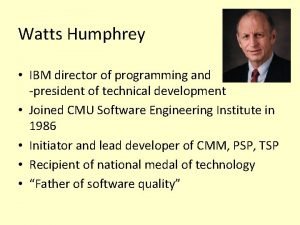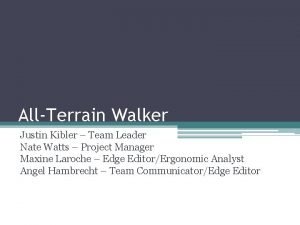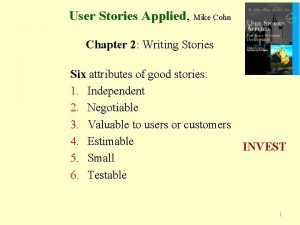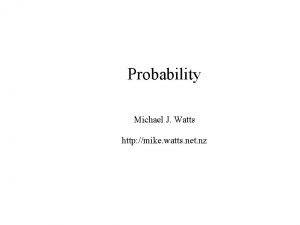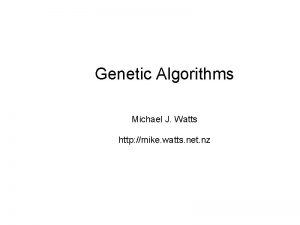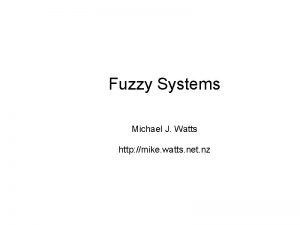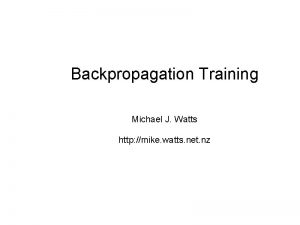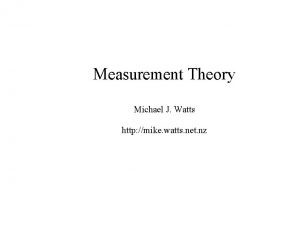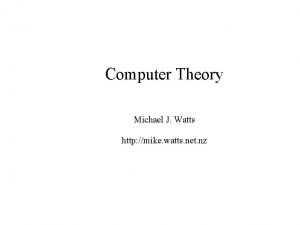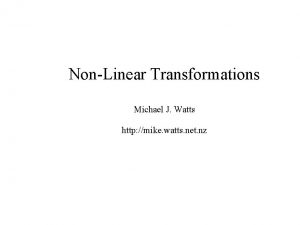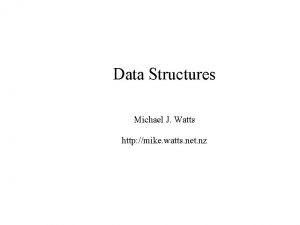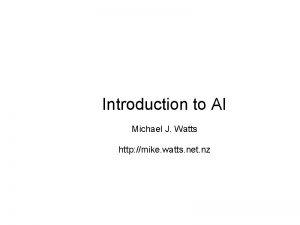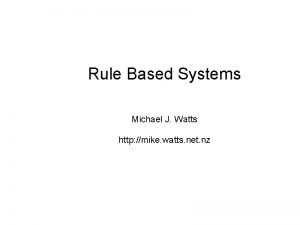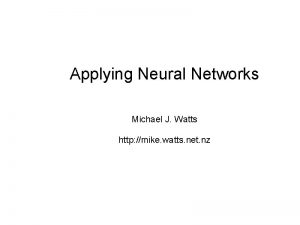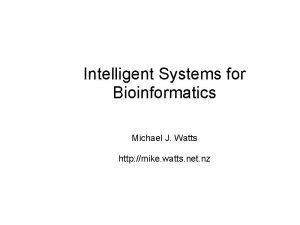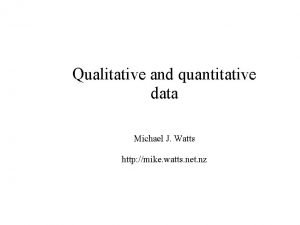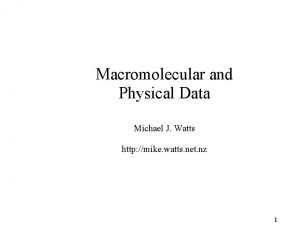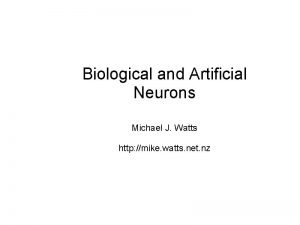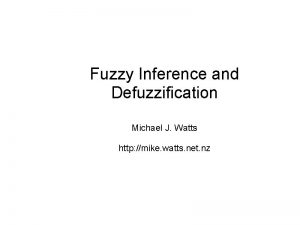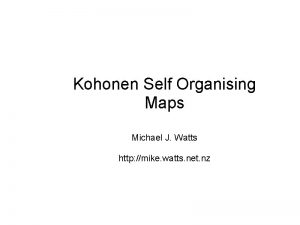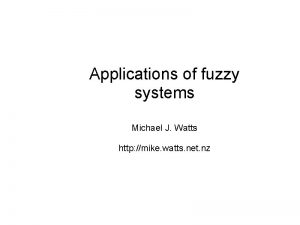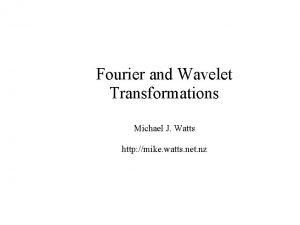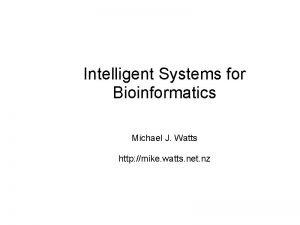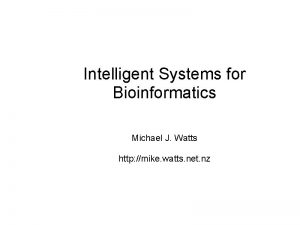Introduction to AI Michael J Watts http mike

























- Slides: 25

Introduction to AI Michael J. Watts http: //mike. watts. net. nz

Lecture Outline a. Artificial / Computational intelligence b. CI models

Computational Intelligence a. What’s it all about? a. The Turing test b. An alternative definition

The Turing Test a. Proposed by Alan Turing in 1950 b. Deals with the question: “Can machines think? ” c. Turing thought this question absurd d. How to define ‘think’? e. Dealt with it with a thought experiment

The Turing Test

The Turing Test a. Man’s objective is to convince interrogator that he is a woman b. Woman’s objective is to help the interrogator c. After a while, the interrogator must decide which is which d. Now, replace the man with a computer

The Turing Test

The Turing Test a. Will the interrogator decide wrongly as often as before? b. In other words, can the machine convince the interrogator that it is human as often as a man can pass as a woman?

The Turing Test a. “The Turing Test is no more a test for intelligence than it is a test for femininity… A man doesn’t become a woman because he can fool you into thinking that he’s a woman. By the same token, a machine doesn’t become…an intelligent machine, just because it can fool you into thinking that it’s thinking” a. David B. Fogel, Blondie 24: Playing at the Edge of AI pg 11

An Alternative Definition a. “Intelligence is the capability of a decisionmaking system to adapt its behavior to meet its goals in a range of environments” a. David B. Fogel, Blondie 24: Playing at the Edge of AI pg 14

Computational Intelligence a. Artificial Intelligence is now called Computational Intelligence b. Why the change? a. Fashion? b. Politics? c. More accurate?

CI Models a. We will be studying three general paradigms of CI a. Rule based and fuzzy systems (FS) b. Artificial Neural Networks (ANN) c. Evolutionary Computation (EC)

CI Models a. Why cover different models? b. No Free Lunch Theorem a. If there is a problem A on which the algorithm performs well, there will be a problem B on which the algorithm performs poorly b. Nothing is good at everything

Rule-Based Systems a. Systems that make decisions based on rules b. Used when the rules can be stated c. Crisp rules a. When the numbers dealt with are always exact b. Can be a pain in the neck to program, though d. Fuzzy rules a. deals with inexact concepts – ‘bigger’, ‘smaller’, ‘faster’ b. easier to state rules c. Optimisation can be difficult

Rule-Based Systems a. First, define the rules b. Easier said than done c. Are the rules consistent? d. Are the rules complete? a. Cover all possibilities e. Fuzzy systems a. define the fuzzy membership functions

Artificial Neural Networks a. Based on models of the brain b. Consist of network of interconnected subunits a. Neurons c. Used when the rules are not known d. ANN are learning structures a. Don’t need to be told the answer to the problem

Artificial Neural Networks a. Many kinds in existence b. We will be covering only three a. Perceptrons b. Multi-layer Perceptrons (MLP) c. Kohonen Self-Organising Maps (SOM)

Artificial Neural Networks a. Which networks are used depends on the application b. perceptrons useful for simple problems a. linear separability c. MLPs handle problems perceptrons cannot a. Non linearly separable

Artificial Neural Networks a. Perceptrons and MLPs both use supervised learning a. Must know the target values the network is learning b. SOMs are unsupervised a. capture clusters in the data b. vector quantisers

Artificial Neural Networks a. Care must be taken with the data used to train the network a. It is easy to badly train an ANN b. Other circumstances where ANN don’t function well

Evolutionary Algorithms a. Based on the mechanisms of natural selection and biological evolution b. Evaluates fitness of (initially) random solutions c. More fit individuals produce more offspring d. Search algorithms e. Used when brute-force (exhaustive) search is not feasible f. Useful for multi-parameter optimisation

Evolutionary Algorithms a. Several kinds exist a. Genetic Algorithms (GA) b. Evolution Strategies (ES) c. Evolutionary Programming (EP) d. Genetic Programming (GP) b. Require the following characteristics a. representable b. Fitness (objective) function

Representation a. Must be able to represent the problem in the algorithm b. some means of encoding candidate solutions

Evaluation a. some means of rating candidates must exist a. binary ratings are no good a. right/wrong b. fitness function must be objective c. fitness function must separate good candidates from bad candidates d. Most problem dependent component of EA

Conclusions a. Computational intelligence is hard to define b. Oldest attempt is the Turing Test, but not very accurate c. Many different kinds of CI about d. Deal with 3 in this course a. Rule based systems b. Neural Networks c. Evolutionary Algorithms
 Ohms vs watts
Ohms vs watts Ohm's law states
Ohm's law states Corriente y voltaje
Corriente y voltaje Elizabeth watts ship
Elizabeth watts ship Eaton arc flash handbook
Eaton arc flash handbook Watts v united states
Watts v united states Watt's indicator mechanism
Watt's indicator mechanism Dr jacqueline watts
Dr jacqueline watts Watts-strogatz
Watts-strogatz 108 mustang way
108 mustang way Tva
Tva A dishwasher uses 700 watts
A dishwasher uses 700 watts Diesen v samson
Diesen v samson Sean watts
Sean watts Charlie watts
Charlie watts Solia lumii
Solia lumii Mettre les watts
Mettre les watts Grublers criterion
Grublers criterion Watts humphrey
Watts humphrey Dr mark attalla
Dr mark attalla Nate watts
Nate watts Http //mbs.meb.gov.tr/ http //www.alantercihleri.com
Http //mbs.meb.gov.tr/ http //www.alantercihleri.com Siat.ung.ac.id
Siat.ung.ac.id Mike williams erlang
Mike williams erlang Mike mazzalongo
Mike mazzalongo User stories applied
User stories applied
